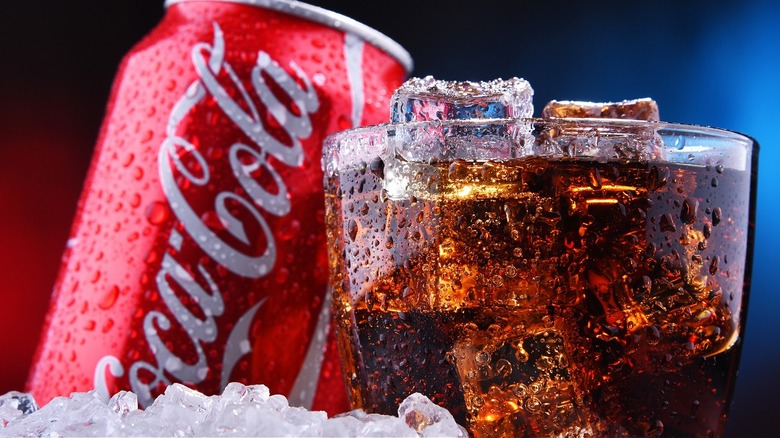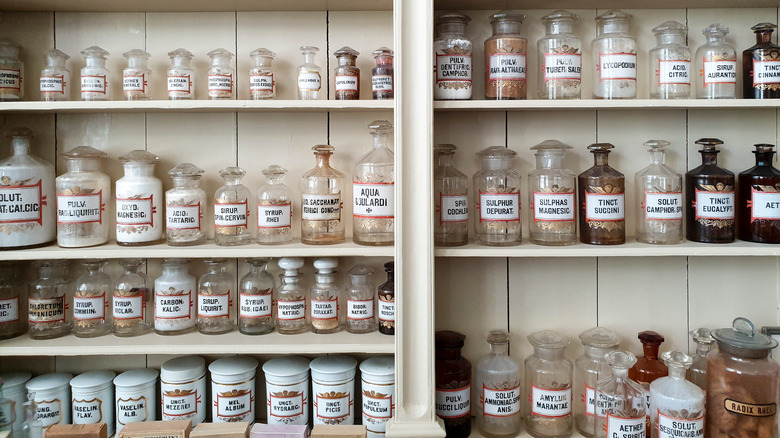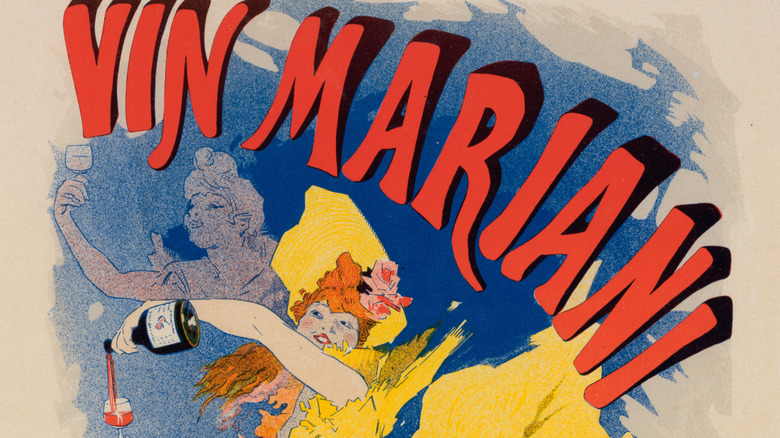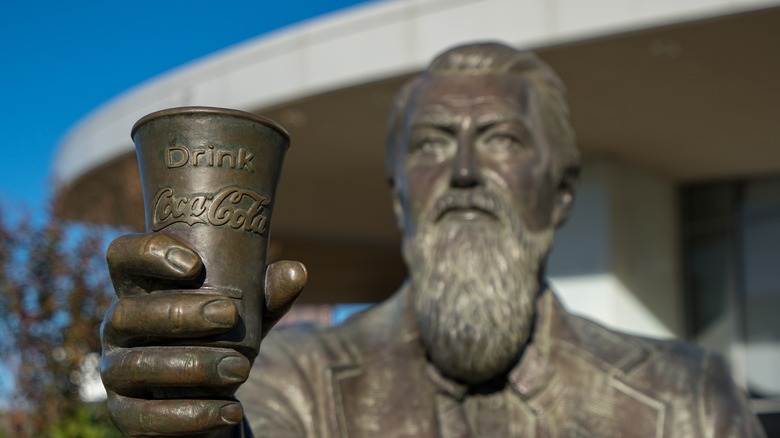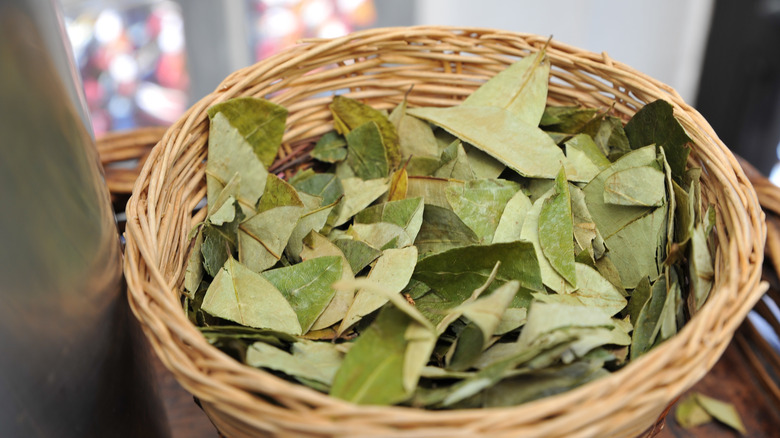Coca-Cola Is Still In The Cocaine Business
If you've ever explored the history of Coca-Cola, you've probably heard that the soda once contained cocaine. And it's basically true: both parts of the brand name come from its original ingredients, which the company considers essential to its formula. The "coca" in Coca-Cola is from "coca" leaves, which are indigenous to the Andes region of Latin America and have been used for medicinal purposes in the area for centuries; the leaves contain small amounts of the alkaloid that provide the drugs' signature high. The cola, in turn, comes from the African "kola" nut which contains caffeine. Both of these plants were present in the original formula and still are today, albeit with modifications.
Back when Coca-Cola began, cocaine wasn't a strange ingredient to include. Lots of people at the time were interested in the medicinal properties of plants. Europeans got especially excited over plants they had only recently discovered — like those native to other continents. Once they got their hands on coca leaves, they quickly discovered the potent cocaine alkaloid, which was first isolated by Dr. Albert Nieman in 1860 and became quite prevalent thereafter (via NCBI). Coca-Cola originally contained those leaves with all their alkaloids, and coca leaf extract is still in the drink mix. While the soft drink no longer contains cocaine, the company is still in the business of importing coca leaves (per Gastropod), and creating cocaine in order to produce its ubiquitous soft drink.
But it's complicated. Explaining the Coca-Cola-cocaine connection requires a bit of backstory and explanation.
A patent medicine laced with cocaine
Coca-Cola was first invented by a man named John Stith Pemberton, who had a rough go of it during his lifetime. A Georgia native, Stitch obtained a medical degree at 19 and worked as a pharmacist in his native state before enlisting in the Civil War (via MIT). After being severely wounded as a Confederate soldier, Pemberton became addicted to morphine to treat his pain. He struggled financially throughout his life (the two fires that burned up his business establishment didn't help, either).
But he knew enough to recognize a good thing when he saw it. In his day, "patent medicines" were all the rage. These drinks made outrageous health claims and were not usually patented. But these fix-all pseudo-medicinal beverages proved quite popular, however ineffective they may have been. As a pharmacist, Stitch was familiar with many of these and interested in developing his own, since the drinks could be very lucrative for their makers. One of the era's best sellers was a celebrated concoction known as Vin Mariani, a favorite of figures as famous and diverse as the Pope, Queen Victoria, and Thomas Edison (via Atlas Obscura). Vin Mariani was made of Bordeaux wine, mixed with 6 milligrams of coca leaves per ounce, providing a nice buzz and pick-me-up all at once.
Pemberton decided to whip some up himself, which led to his simple — but historic — innovation.
It didn't start out as a soft drink
Pemberton copied the concept with a twist, adding in African kola nut, which contains caffeine. "Pemberton's French Coca Wine" was invented, complete with a winning combination of alcohol, cocaine, and caffeine, and proved quite unsurprisingly popular in its own right. Ulysses S. Grant himself was a fan (after all, who needs foreign Vin Mariani when you can buy local and get some caffeine in the mix?).
But as concerns about alcohol and its effects grew, Atlanta went dry. Since wine was no longer to be had, Pemberton swapped out the pricey red for carbonated water (via Gastropod). He named the beverage for its special ingredients: Coca and Kola. When his bookkeeper suggested spelling both with a letter C to make it look better visually (via Thought Co.), Pemberton agreed and Coca-Cola's signature beverage was born.
Asa Candler bought Pemeberton's formula in 1887, which at this point was a dense syrup that could be added on-site to soda water. Pemberton died of cancer in 1888, poor and suffering from his morphine addiction, never knowing the success his formula would become.
But the Reconstruction South was a tough time and a tough place. Times were changing — fast, and there was a great deal of fear in the air. Some of those fears included false, racially-charged notions that cocaine was leading to crime waves among African Americans.
Take Coca Wine, then take out the wine and the coke...
Candler didn't want to be associated with a negative subject. The cocaine would have to go, since it was dragging down the brand image of a healthy beverage for non-drinkers. Candler and Coke were in a quandary: their patented formula, which their name depended on, included coca. How could they say no to cocaine but yes to coca?
Enter the creation of decocainized coca — coca leaves from which the cocaine alkaloid has been deliberately removed.
At the end of the 19th century, there were no laws banning the importation or consumption of cocaine, and the drug was very popular. But as time went on, opposition to the drug grew, and the government got involved. Cocaine was declared illegal in 1914 (via The Atlantic), and the Harrison Narcotic Ban was put into effect, banning the importation of coca leaves. However, the legislation includes a special exemption for coca leaves imported for a certain use: specifically, the decocainized form used by a certain beverage company. Over the decades, as the drug regulations continue to accrue, those special loopholes get added each and every time — clauses that benefit one (and only one) of the biggest companies in the world: Coca-Cola (Coke can be found in all but two countries on the planet).
Those legally imported leaves are then processed at a chemical plant in Northern New Jersey, Maywood Chemical Corp (now owned by Stepan).
Keeping it pure: Coca Cola makes (and destroys) its own
The plant takes the Ecgonine alkaloid out of the leaves so that Coca-Cola can use those de-cocainized leaves to make Coca-Cola.
But in order to take the cocaine out of the leaves, you need to isolate the cocaine, creating pure forms of the drug. To quantify the kind of volume we're dealing with, the company imported 175,000 kg of coca leaves in 2003 alone — enough to make an estimated $200 million worth of cocaine (via The Atlantic). Some of this cocaine is then utilized for medicinal purposes, but there is more of it than legitimate medical uses require.
So what happens to the rest of the cocaine? Under the supervision of the DEA, the extra cocaine is destroyed.
The biggest irony of all is that coca leaves do not contain large quantities of cocaine. And today's coke contains only small quantities of coca leaf. Indeed, Coca-Cola's soda has gone through plenty of flavor changes. If Coke left the coca leaves in its beverage without decocainizing it, we'd likely be none the wiser (and none the higher).
But we'd all be missing out on a great story.
